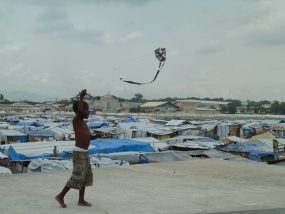Immigrant, Refugee, and Migrant Health Branch
Who We Are

CDC’s Division of Global Migration and Quarantine (DGMQ) works to assess and promote the health of individuals coming to live and work in the United States. This work includes mandatory health screenings for all immigrants and refugees entering the United States, as well as overseas vaccination and parasitic treatment programs for refugees. These activities prevent the importation of infectious diseases, particularly tuberculosis, and provide relevant health information for healthcare providers continuing care after refugees arrive in the United States.
What We Do
The DGMQ Immigrant, Refugee, and Migrant Health (IRMH) Branch works to protect the public health of the United States by safeguarding the health of US-bound immigrant and refugee populations by:
- Tracking and responding to disease outbreaks in refugee populations overseas and in the United States
- Developing Technical Instructions and training healthcare providers who perform mandatory overseas pre-departure medical exams to ensure that health conditions are documented and treated as required
- Promoting, monitoring, and improving the health of children adopted overseas
- Educating immigrant and refugee groups and partners about disease prevention and good health practices
- Coordinating with domestic health departments, foreign health agencies, and nongovernmental organizations to develop, implement, and evaluate programs that improve health outcomes in globally mobile populations
Where We Work

DGMQ works in the United States and overseas to promote the health of immigrants and refugees and keep infectious diseases out of the United States. Domestically, IRMH collaborates with state and local health departments to improve the healthcare and monitoring of medical conditions in these populations after their arrival in the United States. In addition to its US-based offices, IRMH operates regional field programs in Jordan, Kenya, and Thailand, which cover the Middle East, Africa, and Asia, respectively.
How We Work Together
IRMH works with partners in the United States and overseas to meet its refugee and migrant health goals.
International partners include the United Nations Refugee Agency; the US State Department Bureau of Population, Refugees and Migration; and the International Organization for Migration. They help IRMH conduct the mandatory overseas medical examinations, transmit examination records to partner agencies and organizations in the United States, and connect mobile populations with domestic resources to ensure a continuum of care.
Stateside partners, including the Department of Health and Human Services Office of Refugee Resettlement, state and local health departments, refugee resettlement agencies, and the Association of Refugee Health Coordinators, monitor the health of refugee populations after their arrival in the United States.
Program in Action

Tracking and Responding to Outbreaks:
- Track disease outbreaks to improve understanding of the epidemiology of diseases of concern in immigrants and refugees, including tuberculosis and vaccine-preventable diseases.
- Develop guidelines to respond to disease outbreaks and other health events affecting US-bound immigrants and refugees.
- Build capacity for healthcare partners and strengthen international partnerships.
Pre-departure Medical Screening and Treatment Programs:
- Develop technical instructions and train overseas physicians and assure the quality of medical screening and laboratory diagnostics for US-bound refugees and immigrants, including children adopted overseas.
- Oversee the Vaccination Program for US-bound Refguees and the presumptive treatment program for malaria and intestinal parasites.
Post-departure Medical Follow-Up:
- Develop guidelines related to refugee populations for domestic healthcare providers, ensuring continuity of care upon refugees’ arrival to the United States.
- Manage the Electronic Disease Notification system for sharing records of the overseas examination of immigrants and refugees with state and local health departments for post-arrival followup.